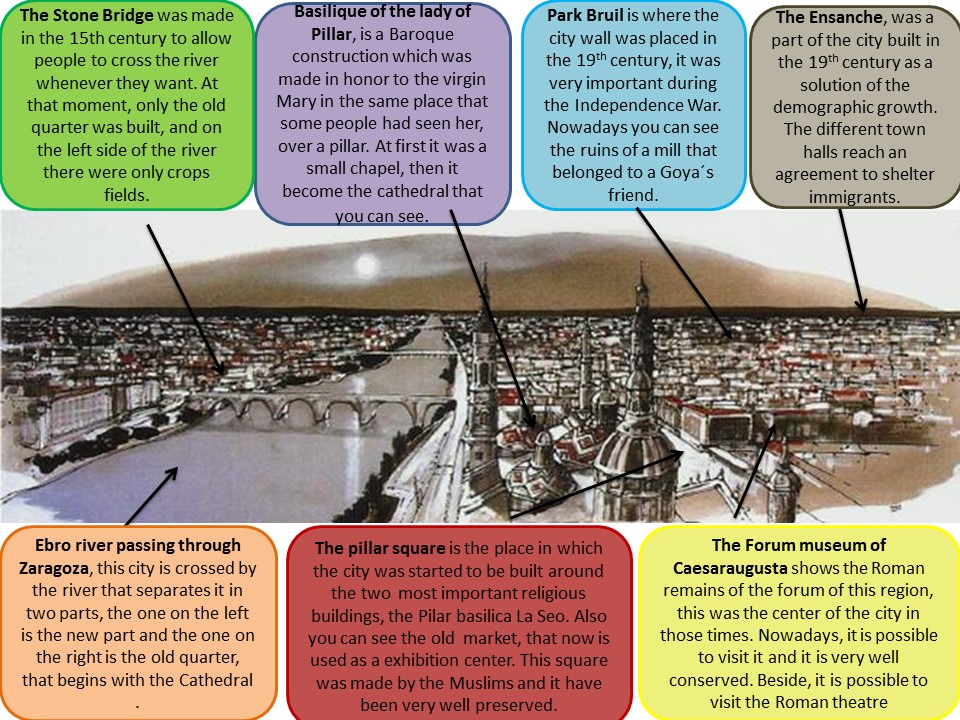This painting represents the city of Zaragoza in the late 20th century in Spain, by Joan Soler, a modern painter from Mallorca. The image belongs to a private collection. This type of image is called “Zenith” and it means that the place from where we can see the city in the picture is taken from the top to the bottom, thus, the perspective seems that the subject is situated perpendicular to the ground.
Zaragoza is a very big and important city in the north of Spain. It is the capital of Aragon region and is very well-known because of the Basilica of Pilar and other significant monuments. The image portrays a lot of differences between the old quarter and the new part of the city. The left part of the city, to the other side of the river Ebro, started to be constructed in the last decades of the 20th century and became a new neighborhood with a large quantity of people living there.
Zaragoza is a place influenced by many cultures so you can notice some differences within the city. It has the characteristics of a Roman city, so the two most important elements were the cardus and decumanus avenues, two streets that crossed the city from the North to the South and from the West to the East. However, in the medieval age a big city wall was built and the urban layout changed a little bit, becoming more irregular. As we can see in the picture the two elements that they used to connect the city centre with the suburbs were two bridges. Those bridges were too important because they were the main way to join the different parts of the city to the outskirst and the cropfields. In the first place we can see the “Stone Bridge” that today keeps its original name; in the second place we can see the “Tables Bridge” that now is called “Puente del Pilar”.
The street that can be seen in the center of the image is the Echegaray y Caballero Street. In this place you can see the back part of the basilica, which is the most important part for the painter. However, the square that appears in the foreground alongside with the river, looks like the main element for him and also for a great number of citizens. These elements are those that appear more detailed, so it makes us think that the painter wants to stand them out. It is curious because the place where the Basillica of Pilar is settled was the same where it is supposed that the Virgin Mary appeared. At first they had told to build a small chapel but in the Baroque era they constructed this major temple. It is also said that our lady of the Pillar save Zaragoza in the second world war when the enemies army throw away three bombs, that nowadays are on the wall of the cathedral, because they were found at the floor without exploding.
In the end of the 19th century it had become clear for the different town halls of Zaragoza that were necessary a few deep changes in the city to give content to the immigrants of the rural exodus and to adapt the city to the new economic and social realities, this new area was called Ensanche. As in other Spanish cities, the town hall planned the tracing of a «New Zaragoza «, out of the historical center with new buildings and wide and regular streets. It was expected that the citizens from Zaragoza would go progressively leaving the old Zaragoza and they would be established in the newest and best housings. The problem of the Ensanche is that they did not take into account the social reality of that Spain, most of the population was very poor and was not having incomes to be able to buy or rent the new housings. That is why these people went to live to buildings of worse conditions and in slums removed from the center and with scanty services, whereas the Ensanche was a place where the social groups with a higher level of incomes fixed their residences.
The workers were mainly dedicated to the secondary and tertiary sector. In the 20th century, they develop industries as the metallurgy, food industry, electrical production and chemical industry. Besides this, there were important sugar factories and as modern services, the railway industry. Zaragoza was placed in a strategic location, which makes the railway to have much more relevance from the 19th century on.
Cristina Magallón López

